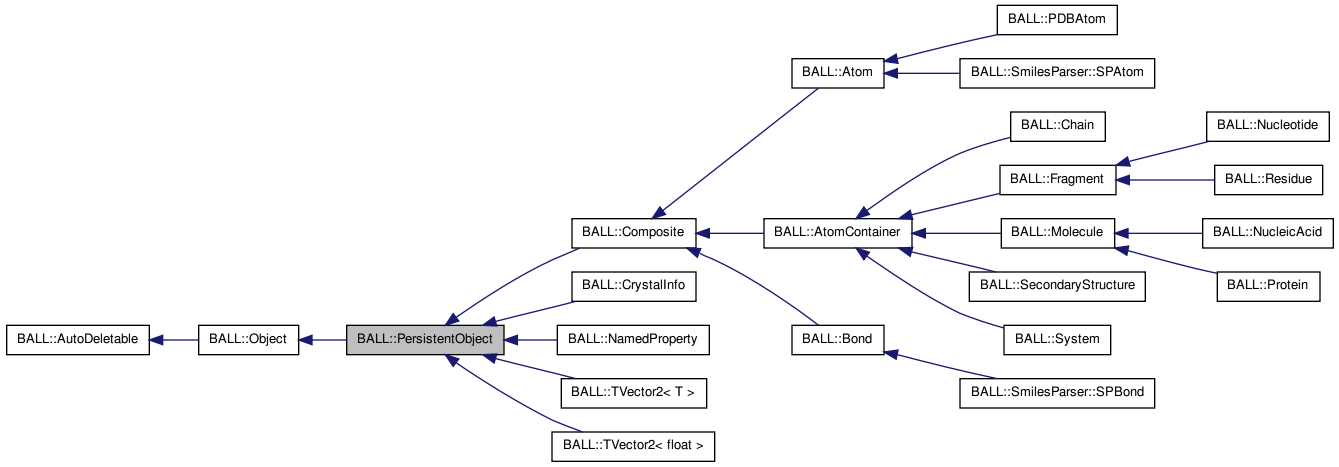BALL::PersistentObject Class Reference
[Object Persistence.]
#include <BALL/CONCEPT/persistentObject.h>

Public Member Functions | |
Constructors and Destructors | |
| PersistentObject () | |
| virtual | ~PersistentObject () |
Persistent Writing and Reading | |
| PersistenceManager & | operator>> (PersistenceManager &pm) const throw (Exception::GeneralException) |
| virtual void | persistentWrite (PersistenceManager &pm, const char *name="") const throw (Exception::GeneralException) |
| virtual void | persistentRead (PersistenceManager &pm) throw (Exception::GeneralException) |
| virtual void | finalize () throw (Exception::GeneralException) |
Detailed Description
The persistent object. Each object that needs persistence, has to be derived from PersistentObject to define an interface to the PersistenceManager .
- The class itself has no functionality except for the
operator >>.
Definition at line 27 of file persistentObject.h.
Constructor & Destructor Documentation
| BALL::PersistentObject::PersistentObject | ( | ) | [inline] |
Default constructor. The default constructor has no functionality.
Definition at line 39 of file persistentObject.h.
| virtual BALL::PersistentObject::~PersistentObject | ( | ) | [inline, virtual] |
Destructor. The destructor has no functionality.
Definition at line 48 of file persistentObject.h.
Member Function Documentation
| virtual void BALL::PersistentObject::finalize | ( | ) | throw (Exception::GeneralException) [inline, virtual] |
Finalize the deserialization. This method is called for all objects after their pointers have been demangled. It is intended for the adaptation of internal data structures. For example, the bond class has to swap first_ and second_ depending on the order of the atoms. It is usually left unimplemented.
Reimplemented in BALL::Bond.
Definition at line 104 of file persistentObject.h.
| PersistenceManager& BALL::PersistentObject::operator>> | ( | PersistenceManager & | pm | ) | const throw (Exception::GeneralException) |
Stream operator. This operator is used to serialize an instance of PersistentObject. The method first calls pm.startOutput() to write the necessary headers. Then, persistentWrite(pm) is called to serialize the object. Finally, a call to pm.stopOutput() writes all dependend objects and the end marker to the persistent stream.
- Parameters:
-
pm the persistence manager
- Returns:
- the persistence manager (for chaining multiple output operations)
| virtual void BALL::PersistentObject::persistentRead | ( | PersistenceManager & | pm | ) | throw (Exception::GeneralException) [virtual] |
Deserialize the object. This method reads the contents of an persistent object into an (already existing!) object. It is implemented using Layer 1 commands of PersistenceManager. To each write command used in persistentWrite, there should be exactly the same call to a read command in persistentRead. Only the header and trailer (writeObjectHeader/writeObjectTrailer calls) have to be omitted, as the header is read before this method is called (the object type has to be known in advance to dynamically create the object).
- Parameters:
-
pm the PersistenceManager
Reimplemented in BALL::Composite, BALL::NamedProperty, BALL::Atom, BALL::AtomContainer, BALL::Bond, BALL::Chain, BALL::Fragment, BALL::Molecule, BALL::NucleicAcid, BALL::Nucleotide, BALL::PDBAtom, BALL::Protein, BALL::Residue, BALL::SecondaryStructure, BALL::System, BALL::TVector2< T >, BALL::CrystalInfo, and BALL::TVector2< float >.
| virtual void BALL::PersistentObject::persistentWrite | ( | PersistenceManager & | pm, | |
| const char * | name = "" | |||
| ) | const throw (Exception::GeneralException) [virtual] |
Serialize the object. This method serializes the object by calls to Layer 1 methods of PersistenceManager . The first method in the implementation of persistentRead should be a call to pm.writeObjectHeader(*this, name). Likewise the last method in this method should be pm.writeObjectTrailer(name).
- Parameters:
-
pm the persistence manager name the name of the object (0 for writing base classes)
Reimplemented in BALL::Composite, BALL::NamedProperty, BALL::Atom, BALL::AtomContainer, BALL::Bond, BALL::Chain, BALL::Fragment, BALL::Molecule, BALL::NucleicAcid, BALL::Nucleotide, BALL::PDBAtom, BALL::Protein, BALL::Residue, BALL::SecondaryStructure, BALL::System, BALL::TVector2< T >, BALL::CrystalInfo, and BALL::TVector2< float >.
 1.6.3
1.6.3